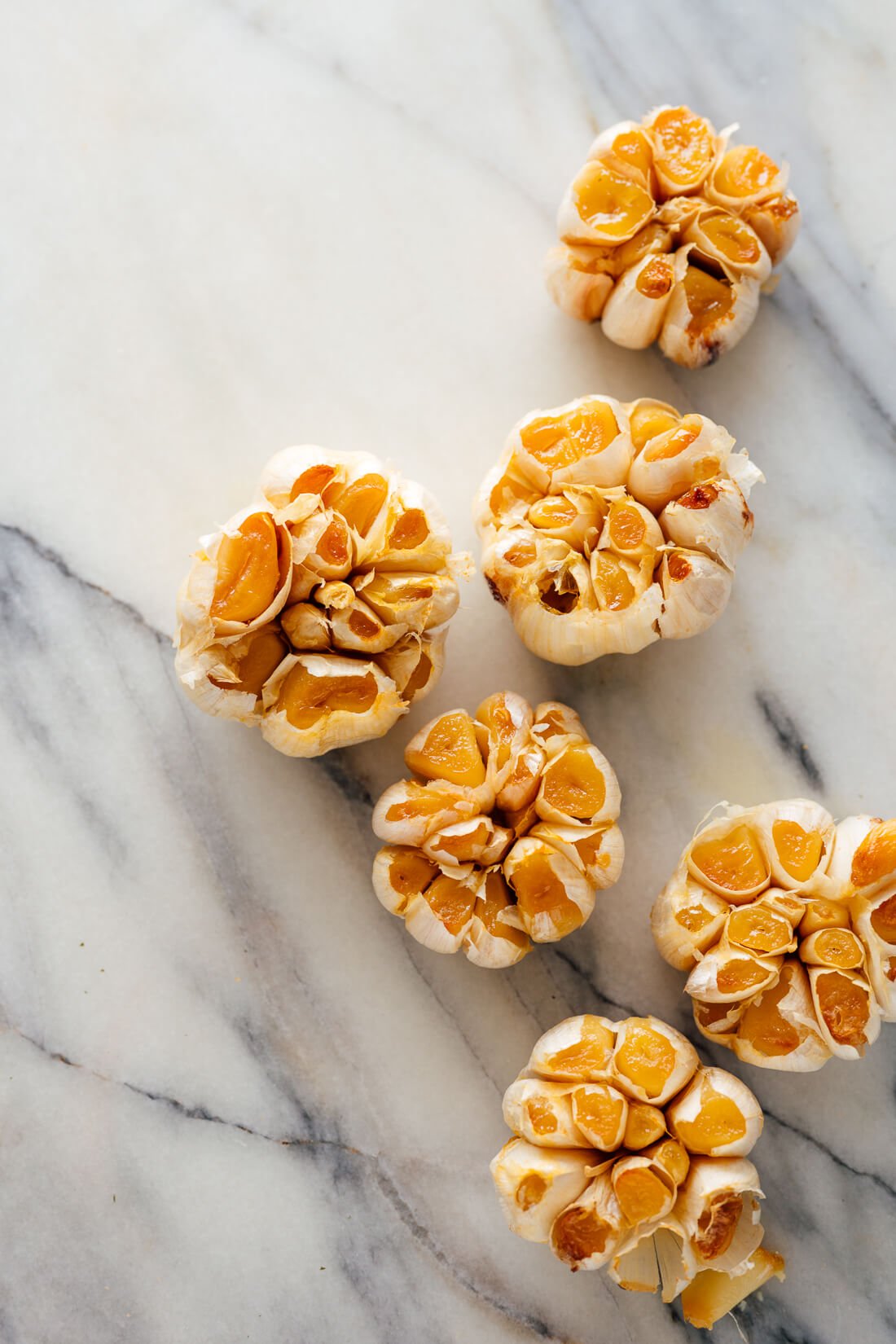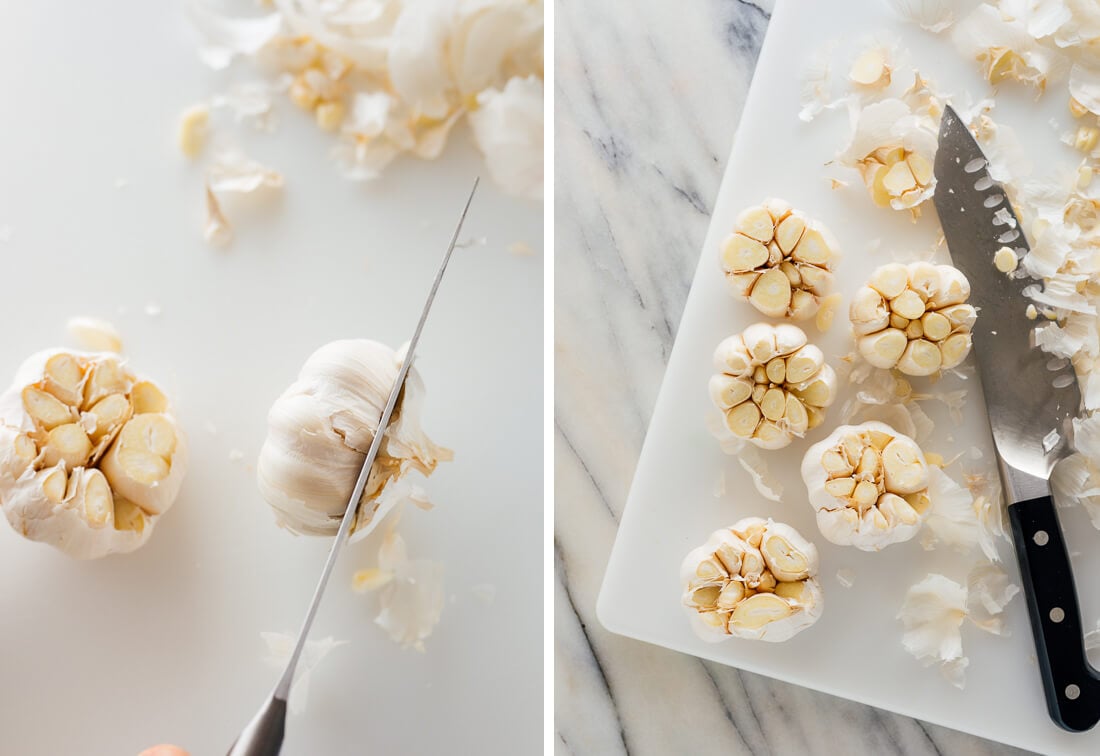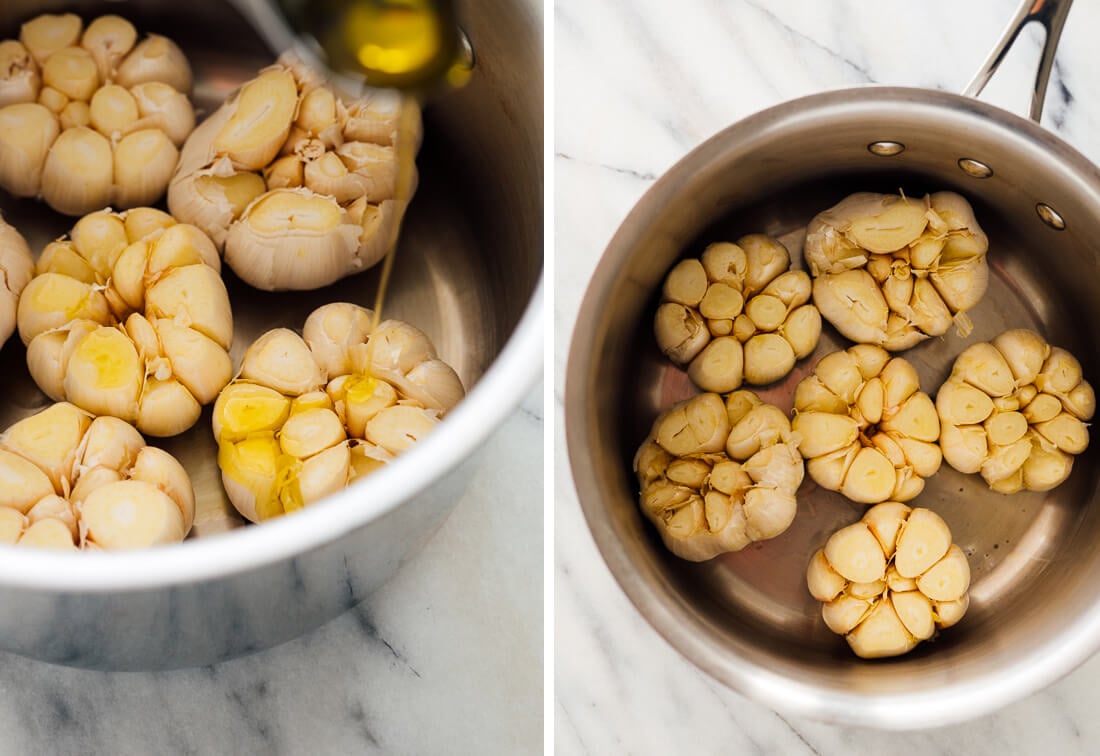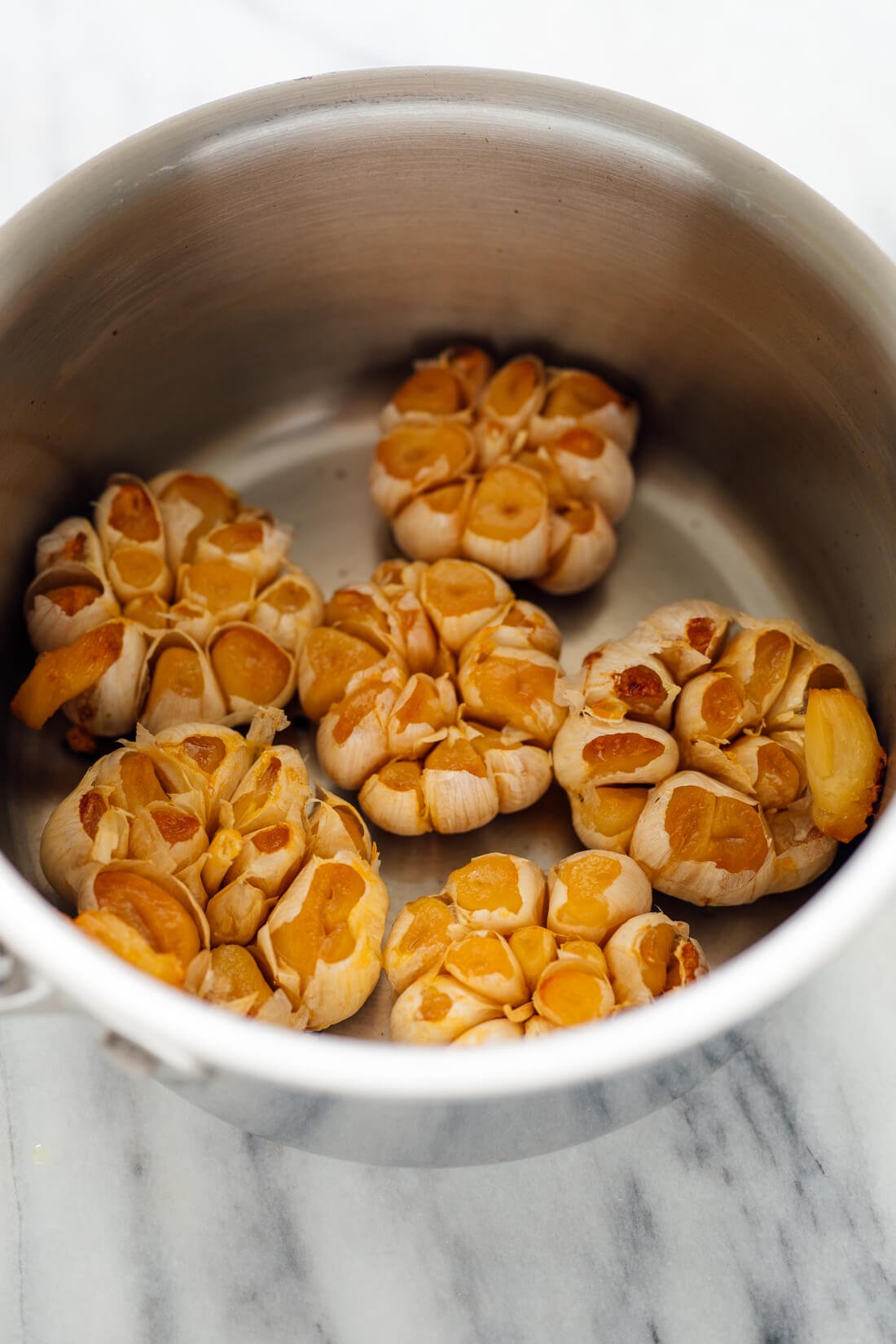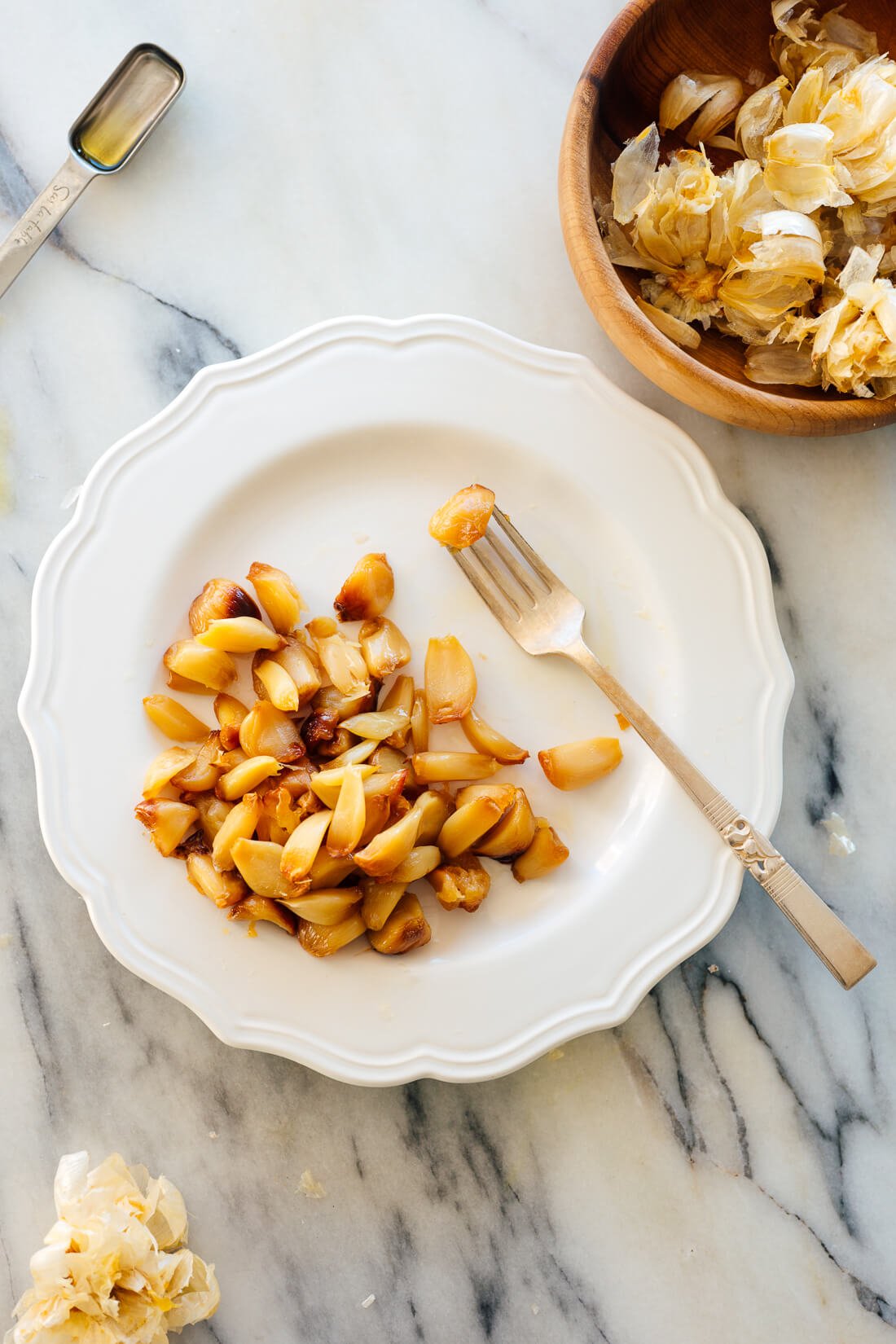Roasted garlic is a revelation. Have you tried it? When you roast garlic long enough, it transforms from pungent and crisp to mellow and soft. It’s irresistibly caramelized and spreads over bread like butter. Roasted garlic seems indulgent, but it’s really just garlic with a little bit of olive oil. Like I said, it’s a revelation.
I’ve loved roasted garlic since my friend introduced me to it in college. We developed a funny routine of roasting tons of garlic, which we enjoyed with crusty bread, too much red wine, and episode after episode of Arrested Development. Back then, we wrapped our garlic in foil, which is what most roasted garlic recipes will tell you to do. These days, I try to minimize our aluminum exposure and cooking waste whenever possible. So, I came up with a foil-free method using basic cooking tools! Let’s roast some garlic.
How to Roast Garlic
I’ve tried roasting garlic every which way. Here’s the best way to do it:
1) Slice off the top of the cloves.
If we don’t expose the cloves, the hot garlic will burst through the papery skins and burn. We don’t want that.
2) Drizzle with olive oil.
Oil increases the surface temperature of anything that it touches, which leads to more caramelization (yum). It also helps prevent the garlic from drying out, so it stays soft and spreadable.
3) Enclose the garlic.
Garlic tends to burn in dry, high heat, so we want to provide an environment that keeps it evenly heated and protected from the elements. Most recipes suggest wrapping it in foil. I place the heads of garlic in a stainless steel saucepan or skillet and cover it with an oven-safe lid. You’ll find more options in the recipe notes.
4) Roast until golden and soft.
The deeper the color, the deeper the flavor (within reason). Roasting could take anywhere from 40 minutes to 70 minutes. There are a lot of factors at play here—the length of time will depend on the size and quantity of the bulbs, their freshness, the amount of oil used, and your roasting preferences.
5) Let the garlic cool briefly, then use or refrigerate promptly.
The garlic will be blazing hot out of the oven, so let it cool for about ten minutes before you touch it. Don’t leave roasted garlic at room temperature for long. According to UC Davis, “Garlic in oil mixtures stored at room temperature provide an ideal environment for Clostridium botulium [botulism] to grow and produce toxin (low acidity, no free oxygen in the oil, and warm temperature). The same hazard exists for roasted garlic stored in oil.” Proper food storage is important!
Looking for a roasted garlic shortcut?
I love a good shortcut, but you’re honestly better off roasting the whole head. I tried roasting individual cloves, and they’re more finicky since they vary in size and need to be stirred often. It seems that the head of garlic provides an ideal roasting environment. If you want to try the shortcut, the same rules apply. Cut the cloves open on one end to allow room for expansion (but leave the rest of the skin intact), toss them in oil and roast them inside a saucepan or something similar. Using oven mitts, carefully shake the pan every ten minutes to cook the cloves evenly. They’re done after 20 to 40 minutes in the oven. Small cloves will finish faster, so you may need to remove those from the pan sooner than the rest.
Watch How to Roast Garlic
Uses for Roasted Garlic
Smear it onto good bread (toasted if you wish) or crackers. Top it off with some flaky salt! (affiliate link) Or perhaps even better—make roasted garlic bread. Make compound butter: Smash the garlic cloves into a paste with a fork and stir in room-temperature butter, to taste (for strongly flavored butter, use equal parts, or soften the flavor with additional butter). Season with salt. Be sure to refrigerate the mixture promptly and use it up within four days. Add it to your favorite recipes: Savory recipes that are rich and creamy or inherently garlicky are great candidates. Think mashed potatoes or baked potatoes with sour cream, buttery or tomato-based pasta dishes or soups, and dips and sauces, such as hummus, tahini sauce or aïoli.
Tip: When replacing raw garlic with roasted garlic, you’ll likely want to add more roasted garlic since the flavor is more mellow.
Garlic Nutrition & Considerations
Garlic is loaded with antioxidants and offers a diverse and unique range of sulphur compounds, the most famous being allicin. Garlic has shown promise in fighting the common cold, reducing blood pressure and cholesterol levels, and detoxifying heavy metals. Learn more about garlic nutrition here. Most garlic studies focus on garlic supplements, not raw or roasted forms. It’s possible that roasting the garlic reduces some of the nutrients available, but I can eat a lot more garlic after it’s been roasted. Maybe it’s a toss-up? It’s delicious no matter what. Garlic is a member of the allium family, which includes onions, shallots and leeks—all of which are very good for you. Buy local or organic garlic when possible. Over fifty percent of the U.S. garlic supply comes from China, and that’s a long way for food to travel. Store garlic in a dry, cool, dark place (like a cupboard, not the refrigerator). It will keep for up to a month. Fair warning: Don’t go too bananas eating roasted garlic—eat more than a head or two, and your stomach might be upset with you the next day. I know that sounds like a lot of garlic, but when it tastes this good, it’s easy to go overboard!

